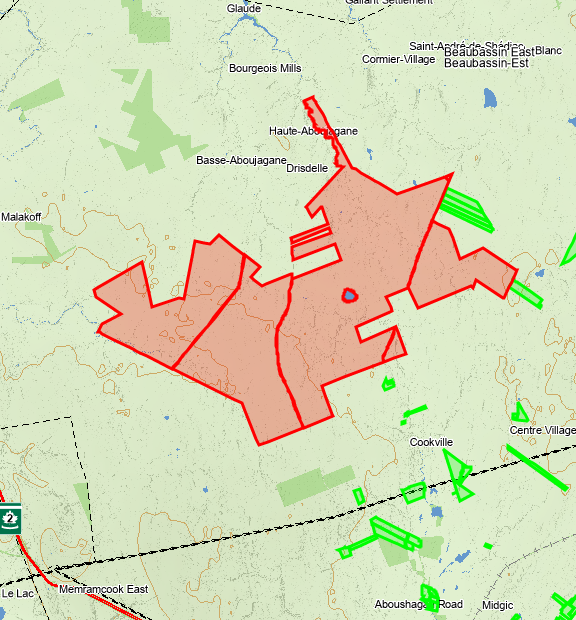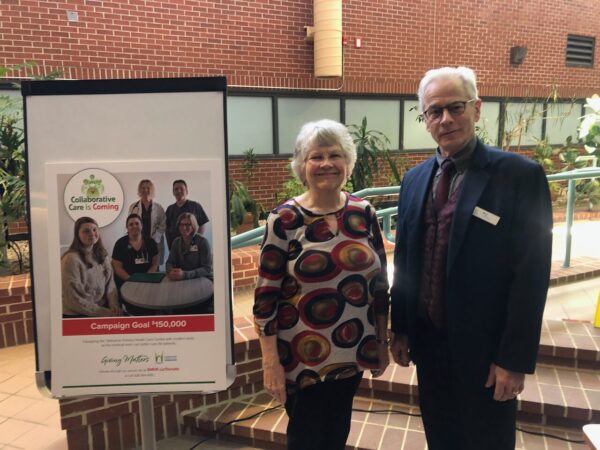It seems as though JD Irving Ltd isn’t a fan of amalgamation.
Four massive parcels of land that belong to the forestry giant have quietly been removed from the future Entity 40, the municipality which is being created by the Province of New Brunswick through the dissolution of the town of Sackville and village of Dorchester, and amalgamation of them with surrounding local service districts.
The change was made during the process for mapping out the municipal election wards of the new Entity 40, and first noticed by Sackville resident Sharon Hicks, who alerted town councillors and media.

The revised boundary still sees Entity 40 stretch northward through Midgic up to border with Beaubassin East, but now large tracts of land have been portioned off the outer boundary to the east and west. CHMA confirmed via the province’s PLANET property information system that much of the now-excluded lands were made up of parcels owned by JD Irving Ltd. The new border line matches the shape of the JD Irving Ltd. property lines in many spots, making it highly likely that the changes were made with the properties in mind.
In response to a CHMA enquiry on the reason for the boundary change, provincial spokesperson Alysha Elliot responded with an emailed statement saying the areas would become part of one of 12 rural districts set up by the province which take up the lion’s share of the province’s area. Elliot said no population was impacted in the change, and “the final revisions have now been made.” Elliot did not comment on why the border change was made, and so far, an interview request with Minister Daniel Allain has not been granted.

The land in question is largely made up of the four large JD Irving properties, though other parcels are involved. The JD Irving parcels are all listed as timberland on New Brunswick’s property registry, and include roughly 4800 hectares in the Midgic Area, 7100 hectares in the Cookville area, 4600 hectares in the Coburg/Port Elgin area, and 8900 hectares stretching from Memramcook East to Lakeburn. Some of the Irving parcels extend beyond the original border of Entity 40, and there are no electors shown living on the parcels, according to the province’s map.

Sackville Mayor Shawn Mesheau told council that the advisory committee he sits on with Deputy Mayor Andrew Black and six other representatives first heard of the border changes at a meeting last week on March 3. Mesheau also said that as he understood it, the advisory committee was asking that land be returned to Entity 40, and Chad Peters would be raising the issue with the province.
“There’s been discussion by the advisory [committee],” Mesheau told council Monday, “a few emails exchanged back and forth. And my understanding from Mr. Peters is that’s been now raised through to the province again, the fact that that should remain included within the Entity. And we’ll discuss that more at our next advisory committee meeting.”
Councillor Sabine Dietz was critical of the province’s move on Monday night, calling it “absurd” that municipalities were told back in December there would be no changes to entity borders, but that changes are now appearing.
“My understanding of it,” said Mesheau, “is that there’s no population, and they weren’t developed areas. It’d be similar to how the quarry at Calhoun was not included,” said Mesheau, referring to the fact that a chunk of the Dorchester local service district near Calhoun, which is home to large rock quarries, has not been including in amalgamation plans and will remain under the sole jurisdiction of the province.
In 1999, residents of Calhoun and the Beaubassin Planning Commission had a battle with a construction company that refused to cease operations on a third gravel pit in the area, despite orders to do so from the commission.
One key difference between the decision to keep Calhoun’s gravel pits away from municipal interference, and the decision to remove JD Irving lands from Entity 40’s jurisdiction: about two and half months.
It was December 21, 2021 when the province delivered final revisions on the boundaries for its extensive amalgamation plans for the province, and it made clear at the time that no further revisions were on the table.
“It’s outrageous,” said Dietz Monday. “We are told things are set in stone and then they change. Things are being made up on the spot.”
“When changes are based on unknown, not-democratically elected people, then I’m not surprised,” said Dietz.
Dietz also told council she had concerns over the removal of resource lands from Entity 40, based on difficulties experienced elsewhere with resource-intense land use. She called on council to “make a really strong statement about this,” and send a letter to Minister Daniel Allain and Deputy Minister Ryan Donaghy.
At the end of Monday’s council meeting, during question period, CHMA asked if there were concerns over the province removing the ability for local government regulation in the timberland areas in question, which now abut Entity 40. CAO Jamie Burke said the regulation of the forested lands would be in the hands of the provincial government, adding that further changes are expected in terms of land use planning in New Brunswick, following from the White Paper on municipal reform.
“There are going to be fundamental changes to land use planning across the province,” said Burke, who is former president of the New Brunswick Association of Planners. “They will introduce statements of public interest that will protect, potentially, resource land,” said Burke. “The province can also introduce their own regulatory regime if they want in those areas.”
Another component of the municipal reform plan is regional planning, said Burke. “Regional planning will in all likelihood involve more than just Entity 40 in some type of coordinated way, whether or not those rural districts fall into that will be yet to be seen,” said Burke.



















